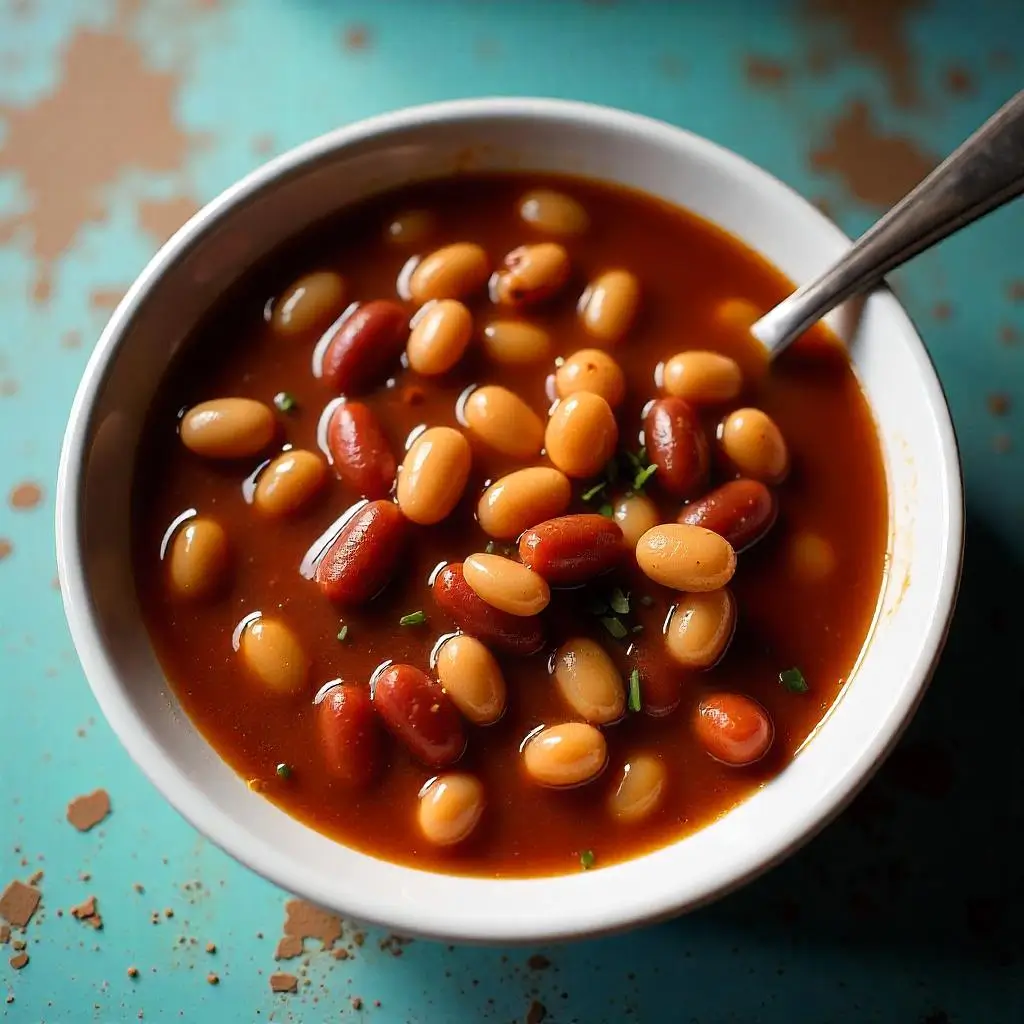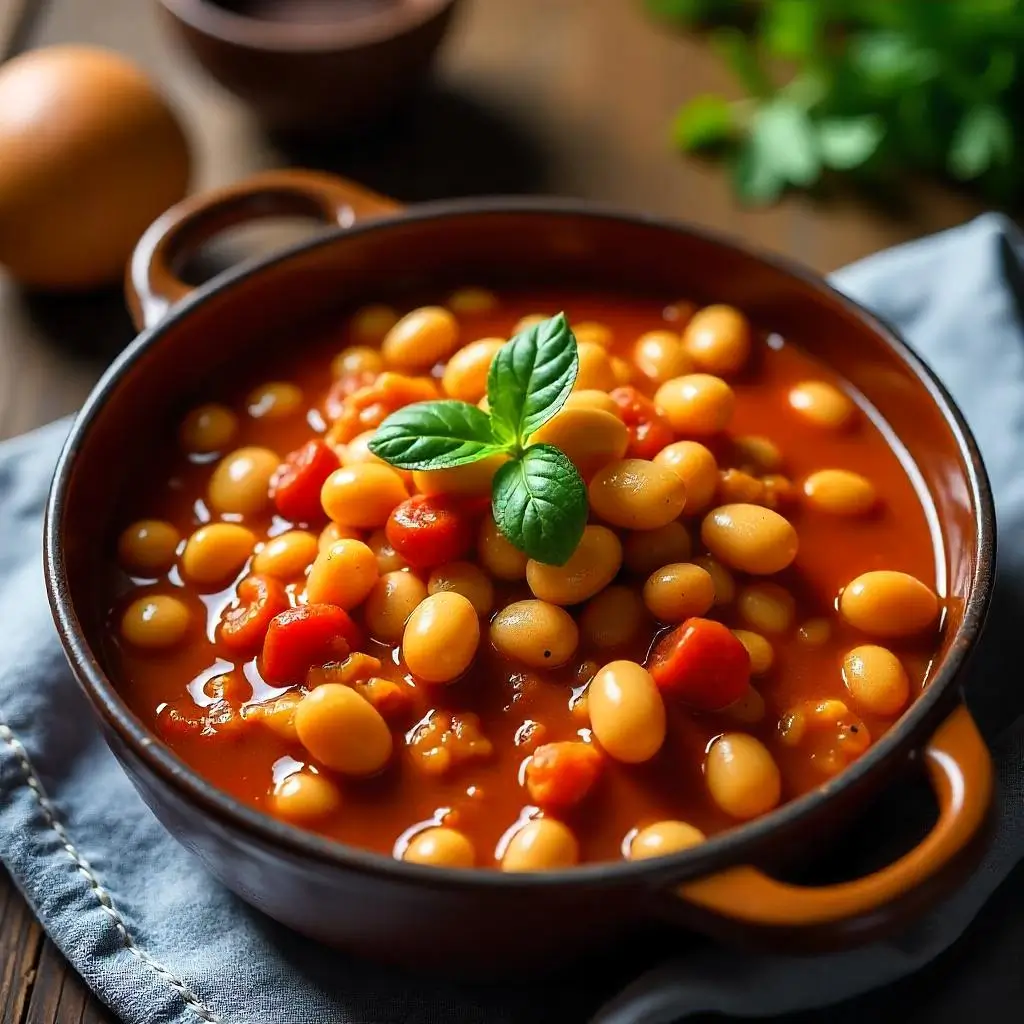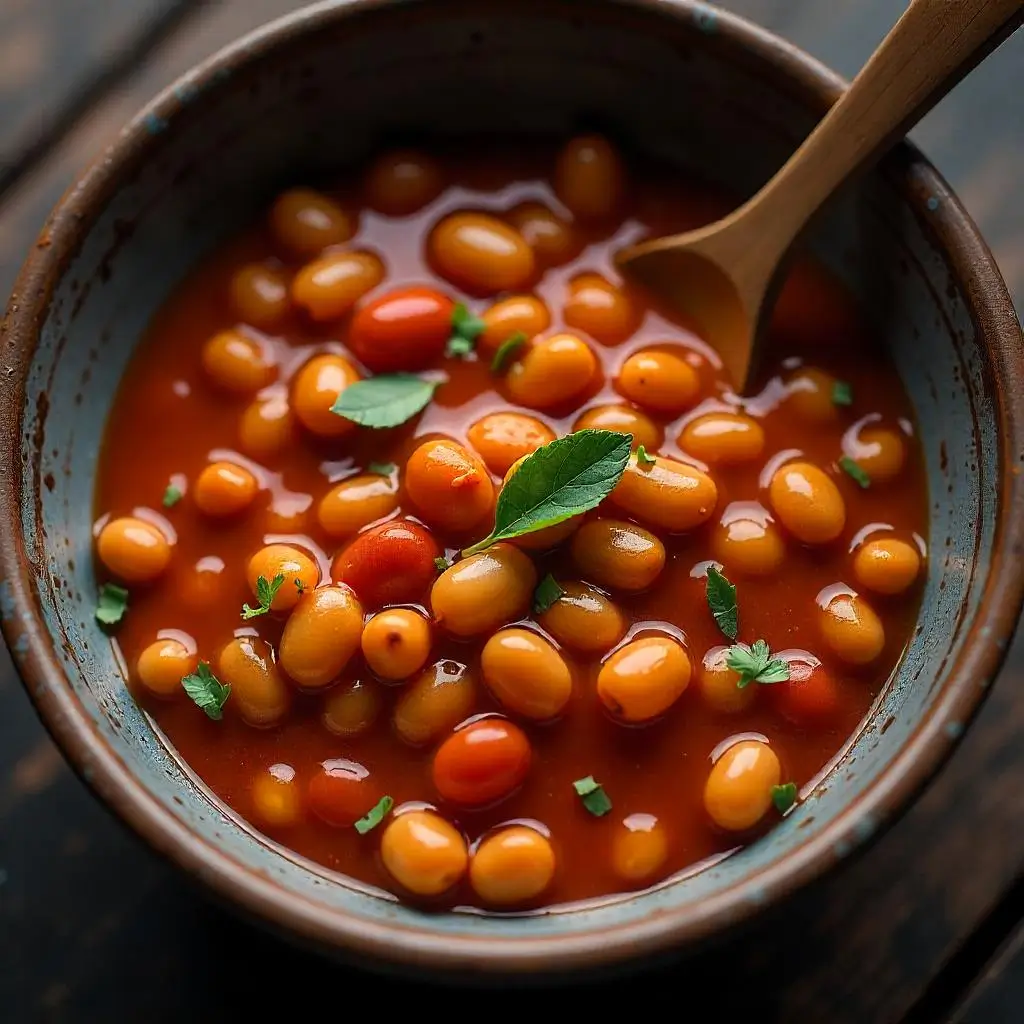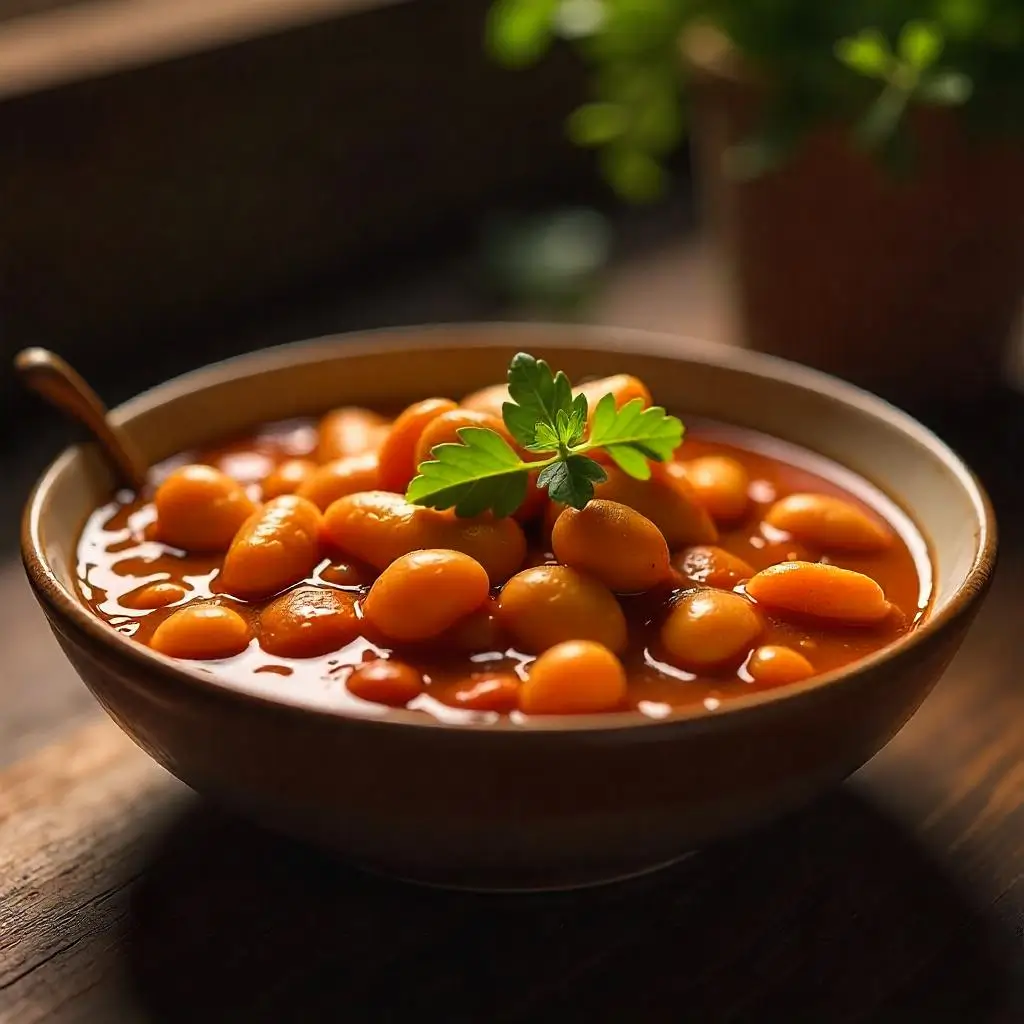Boston baked beans represent far more than just another comfort food dish. Indeed, this iconic New England staple combines the simple elegance of navy beans, molasses, and salt pork through a slow-cooking process that transforms humble ingredients into something truly extraordinary. Furthermore, Daniel Gritzer’s carefully developed approach from Serious Eats demonstrates how traditional techniques can achieve that coveted dark crust and deep, complex flavor without relying on modern shortcuts.
The ultimate goal of authentic Boston baked beans centers on achieving perfectly creamy beans nestled in a thick, caramelized sauce. Moreover, this traditional method accomplishes this feat without depending on contemporary thickening agents like ketchup or tomato paste that many modern recipes unfortunately rely upon.
Table of content :
- Why This Traditional Method Delivers Superior Results
- Complete Ingredients List
- Step-by-Step Instructions for Perfect Results
- Serving and Storage Recommendations
- Expert Cooking Tips and Troubleshooting
- Historical Context: Why Boston Became "Beantown"
- Selecting the Right Beans for Authentic Results
- Understanding Molasses: The Game-Changing Ingredient
- Choosing the Right Pork for Maximum Flavor
- Comparing Different Cooking Methods
- Comprehensive Nutrition Information
- Other recipe
Why This Traditional Method Delivers Superior Results
The Secret Behind Complex Flavors
Although traditional recipes often keep ingredients minimal, this enhanced approach incorporates aromatics directly into the cooking water. Consequently, these additions create multiple layers of flavor that develop throughout the extended cooking process. Specifically, ingredients like onion, carrot, garlic, and herbs such as rosemary, sage, bay leaves, and thyme infuse the beans with subtle complexity while maintaining authenticity.
Starting on the Stovetop Makes All the Difference
Rather than beginning the entire process in the oven, starting the cooking on the stovetop proves remarkably effective. In fact, this technique allows the mixture to reach simmering temperature much faster. As a result, the beans develop better browning and enhanced flavor development once they transition to the oven environment.
The Critical Importance of Pre-Cooking
Before adding molasses and transferring to the oven, the beans must become completely tender. This step cannot be overlooked because molasses significantly slows down the softening process once introduced. Therefore, achieving the proper texture beforehand ensures consistently perfect results.
Natural Bean Starch: The Ultimate Thickening Agent
The key to achieving that perfect glossy coating doesn’t come from artificial thickeners. Instead, the natural starch released by the beans during slow cooking creates the ideal consistency. Consequently, preserving the bean cooking liquid becomes absolutely crucial since it contains concentrated starch and developed flavors that cannot be replicated.
Complete Ingredients List
Main Ingredients
- 1 pound dried navy beans (small white beans)
- 6-8 oz salt pork or thick-cut slab bacon, diced
- 1 medium onion, diced (optional)
- 1/3 cup molasses (blackstrap preferred)
- 1 tablespoon Dijon mustard
- 1/2 teaspoon freshly ground black pepper
- 1 teaspoon salt (adjust to taste)
Aromatic Additions (Optional)
- 1 medium carrot, roughly chopped
- 3-4 garlic cloves, smashed
- 2 bay leaves
- 2-3 sprigs fresh thyme
- 1 sprig fresh rosemary
- 2-3 fresh sage leaves
For Soaking and Cooking
- 2 tablespoons salt (for soaking water)
- 1 teaspoon salt (for cooking water)
- Apple cider vinegar (for final adjustment, if needed)

Step-by-Step Instructions for Perfect Results
Initial Salt Water Soaking
Begin by soaking beans in salted water for at least 12 hours to ensure even cooking. Afterward, rinse and drain thoroughly before proceeding.
Pre-Cooking with Aromatics
Next, cook the soaked beans in fresh water with a pinch of salt for uniform cooking and reduced splitting. Additionally, add optional aromatics like onion, carrot, garlic, and herbs. Continue cooking until beans become completely tender and creamy throughout.
Preserving the Cooking Liquid
When draining the pre-cooked beans, carefully reserve all cooking liquid. This starch-rich, flavorful liquid becomes essential for achieving proper consistency and taste in the final dish.
Preparing the Molasses Mixture
Subsequently, combine molasses with mustard, salt, and pepper. Then, use approximately two cups of reserved cooking liquid to thin the thick molasses. Keep remaining cooking liquid available for later additions.
Stovetop Starting Method
For optimal results, brown the salt pork or bacon in a Dutch oven first. Then, add onion and cook until tender. Following this, add the pre-cooked beans, molasses mixture, and enough reserved cooking liquid to just cover the beans. Finally, bring the mixture to a simmer on the stovetop before transferring to the oven.
Oven Cooking Process
Transfer the uncovered pot to a 325°F oven for approximately four hours or more. During cooking, check every hour or two, adding reserved cooking liquid (then hot water) if surface beans appear too dry. The goal is maintaining enough liquid to prevent drying while allowing crust formation.
Managing the Crust Development
Throughout cooking, stir the beans once or twice to submerge dried surface beans while bringing others to the top. This technique incorporates the developing crust, which enriches overall flavor complexity.
Final Hour Finishing
During the last hour, avoid adding more liquid to allow the sauce to reduce properly. This creates the thick, glossy consistency rather than a thin broth.
Post-Cooking Emulsification
After removing from the oven, stir thoroughly to emulsify the fat, release remaining starch, and create the signature glossy coating that characterizes perfect Boston baked beans.
Final Adjustments
If the mixture seems too dry, gradually add hot water or reserved cooking liquid. Conversely, if too liquidy, briefly reduce on the stovetop if using a Dutch oven. Finally, adjust seasoning with salt and pepper, adding a splash of apple cider vinegar if the sweetness seems overwhelming.
Serving and Storage Recommendations
Serve Boston baked beans hot as a traditional accompaniment to brown bread, cornbread, or alongside barbecued meats. These beans refrigerate well for up to one week and reheat beautifully in a saucepan with additional water if needed.
The equipment required includes either a Dutch oven or large oven-safe casserole dish capable of withstanding several hours of oven cooking.

Expert Cooking Tips and Troubleshooting
Bean Selection and Preparation Tips
- Always sort beans before soaking to remove stones or damaged beans
- Use the float test: discard any beans that float during soaking
- Don’t skip the salt-water soaking; it ensures more even cooking
- Check bean freshness; older beans take significantly longer to soften
Cooking Success Secrets
- Maintain consistent oven temperature; fluctuations affect cooking time
- Use a heavy Dutch oven for even heat distribution
- Keep extra hot cooking liquid ready for additions during baking
- Stir only 1-2 times during cooking to prevent bean breakage
Fixing Common Problems
- Too dry: Add hot cooking liquid or water gradually
- Too sweet: Add apple cider vinegar or lemon juice gradually
- Lacks depth: Stir in a tablespoon of tomato paste during final hour
- Too liquidy: Remove lid and increase oven temperature to 350°F briefly
Achieving Perfect Consistency
The finished beans should coat a spoon but not be soupy. Furthermore, individual beans should hold their shape while feeling creamy inside.
Historical Context: Why Boston Became “Beantown”
A Foundational New England Tradition
Boston baked beans have served as a cornerstone of New England cuisine since the Pilgrim era. Similarly, other cultures developed comparable dishes like Italian fagioli al fiasco, French cassoulet, and Brazilian feijoada. However, Boston’s version became particularly distinctive due to specific local ingredients and cooking methods.
The Story Behind the Nickname
Although Boston earned the nickname “Beantown” due to this famous dish, interestingly, actual Boston residents rarely use this term themselves. Additionally, the city’s connection to molasses became even more dramatic following the Great Molasses Flood of 1919, which literally covered parts of Boston in the sweet, sticky substance.
Traditional Definition and Authentic Ingredients
Authentic Boston baked beans traditionally consist of small white navy beans slow-cooked in an oven or hearth. Furthermore, the essential ingredients include molasses, salt pork, black pepper, and sometimes small amounts of mustard and onion. These components combine to create a thick stew topped with a beautifully caramelized crust. Historical cookbooks consistently confirm these ingredients as the authentic foundation.
Selecting the Right Beans for Authentic Results
Traditional Boston baked beans specifically require small white beans, typically navy beans. These particular beans hold their shape exceptionally well during extended cooking while developing the creamy interior texture that defines the dish. Moreover, their mild flavor allows the molasses and pork to shine without competing elements.
Understanding Molasses: The Game-Changing Ingredient
Historical Evolution of Sweeteners
Originally, Native Americans used maple syrup for similar preparations. However, the triangular trade made molasses abundantly available in Boston, eventually becoming the signature ingredient. Consequently, this historical shift created the distinctive flavor profile we associate with authentic Boston baked beans today.
How Molasses Affects Cooking Time and Texture
Molasses dramatically slows bean softening due to several scientific factors. According to food scientist Harold McGee, the acidity stabilizes pectin, while the sugar content strengthens cell walls and reduces water absorption. Additionally, calcium in molasses further reinforces cellular structure.
While this characteristic historically prevented beans from becoming mushy during long cooking in masonry ovens, it creates timing challenges for modern cooks. Therefore, proper sequencing becomes essential for achieving tender beans within reasonable cooking times.

Choosing the Right Pork for Maximum Flavor
Traditional Salt Pork: The Authentic Choice
Salt pork represents the traditional choice, consisting of thick fat with minimal muscle content. This cut provides pure pork flavor without overwhelming smokiness. When selecting salt pork, avoid pieces that are entirely fat, and always rinse excess salt before using.
Modern Alternative: Thick-Cut Bacon
Alternatively, thick slab bacon or lardons work excellently and can be used in equal or greater quantities. Since bacon comes from the belly and contains more muscle, it provides additional meaty texture. Furthermore, the subtle smokiness can evoke traditional cooking over wood coals, adding historical authenticity.
Comparing Different Cooking Methods
The Ideal But Risky Method: Overnight Oven Cooking
The ultimate technique involves cooking everything in a 250°F oven for approximately 13 hours after proper salt-water soaking. This method produces silky beans, rich crust, and naturally thickened sauce through starch development. However, leaving an oven on overnight presents serious fire safety concerns that many home cooks cannot accept.
Why Baking Soda Doesn’t Work
Testing with baking soda to accelerate cooking produces disappointing results. Although the beans soften faster, they become unpleasantly mushy and overly brown while lacking the deep flavors that develop through slow cooking.
Pressure Cooker Limitations
While pressure cooking softens beans in just 30 minutes, it creates too much liquid without sufficient evaporation. Moreover, the lack of browning means that even finishing in the oven cannot compensate for the missing flavor development.
Slow Cooker Considerations
Although slow cookers might seem perfect for overnight cooking, they cannot provide the dry heat necessary for proper evaporation and surface browning. Therefore, this method fails to achieve the characteristic crust formation that defines authentic Boston baked beans.
The Recommended Safer Method
The most practical approach involves pre-cooking beans separately, then combining with other ingredients for several hours of oven finishing. This technique appears in many historical recipes and provides excellent results with reasonable safety considerations.
Comprehensive Nutrition Information
Per Serving (Based on 8 servings)
- Calories: 285-320
- Protein: 14-16 grams
- Carbohydrates: 45-50 grams
- Dietary Fiber: 12-15 grams
- Total Fat: 8-12 grams
- Saturated Fat: 3-4 grams
- Sodium: 580-650 mg
- Iron: 15-20% Daily Value
- Folate: 25-30% Daily Value
Other recipe :

Creating authentic Boston baked beans requires patience, but the results justify every minute invested. By understanding the science behind molasses behavior, respecting traditional ingredients, and following proper sequencing, home cooks can achieve restaurant-quality results. Most importantly, this method proves that authentic flavors develop naturally through time and technique rather than shortcuts and artificial enhancers.
Whether you’re honoring New England heritage or simply craving deeply satisfying comfort food, these Boston baked beans deliver the perfect combination of creamy texture, complex flavors, and that coveted caramelized crust that has made this dish a beloved American classic for centuries.

How to Make the Boston Baked Beans : Easy Recipe Inside
Description
“Learn how to make classic Boston Baked Beans with this easy recipe! Perfectly sweet, smoky, and hearty—great for family dinners or weekend gatherings.”
Ingredients
Main Ingredients
Optional Aromatics
Instructions
- Sort and rinse beans, removing any stones or damaged beans
- Soak beans in salted water (2 tbsp salt per 8 cups water) for 12+ hours
- Rinse and drain thoroughly before cooking
- Step 1: Pre-Cook the Beans (2-3 hours)
- Place beans in large pot with fresh water to cover by 2 inches
- Add 1 tsp salt and optional aromatics
- Bring to boil, then reduce heat and simmer until completely tender
- Reserve cooking liquid when draining – this is crucial!
- Step 2: Prepare Molasses Mixture
- Mix molasses with mustard, salt, and pepper
- Add 2 cups of reserved bean cooking liquid to thin mixture
- Set aside remaining cooking liquid for later use
- Step 3: Stovetop Start
- Preheat oven to 325°F (165°C)
- Brown salt pork/bacon in Dutch oven over medium heat
- Add onion and cook until tender (5-7 minutes)
- Add beans and molasses mixture
- Add enough cooking liquid to just cover beans
- Bring to simmer on stovetop
- Step 4: Oven Cooking (4+ hours)
- Transfer uncovered pot to oven
- Bake 4+ hours, checking every hour
- Add reserved liquid if beans on top get too dry
- Stir 1-2 times during cooking to rotate beans
- Stop adding liquid during final hour for thick sauce
- Step 5: Final Touches
- Remove from oven and stir thoroughly
- Adjust consistency with hot water if too thick
- Season to taste with salt, pepper, or vinegar
- Let rest 10 minutes before serving
Day 1: Soaking
Day 2: Cooking
Notes
- For the best flavor, use dried navy beans and let them soak overnight before cooking. Traditional Boston Baked Beans are slow-cooked to develop their signature deep, rich taste, so don’t rush the process. Feel free to adjust the sweetness by adding more or less molasses or brown sugar. These beans taste even better the next day—perfect for leftovers!